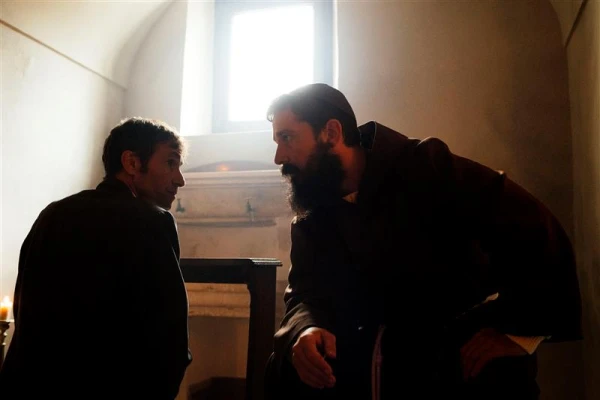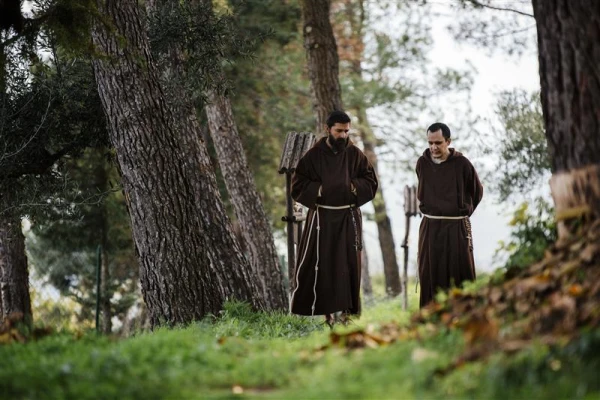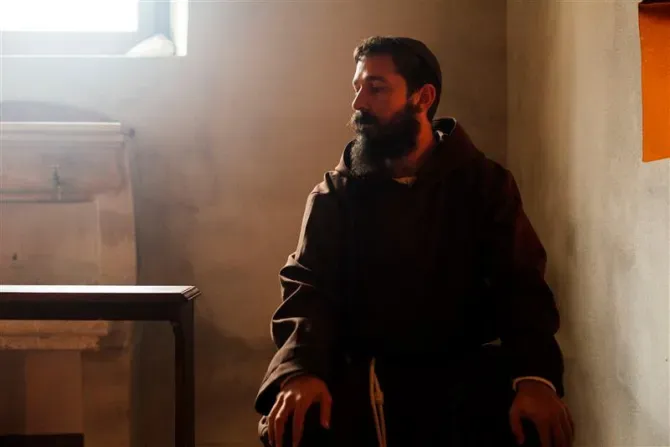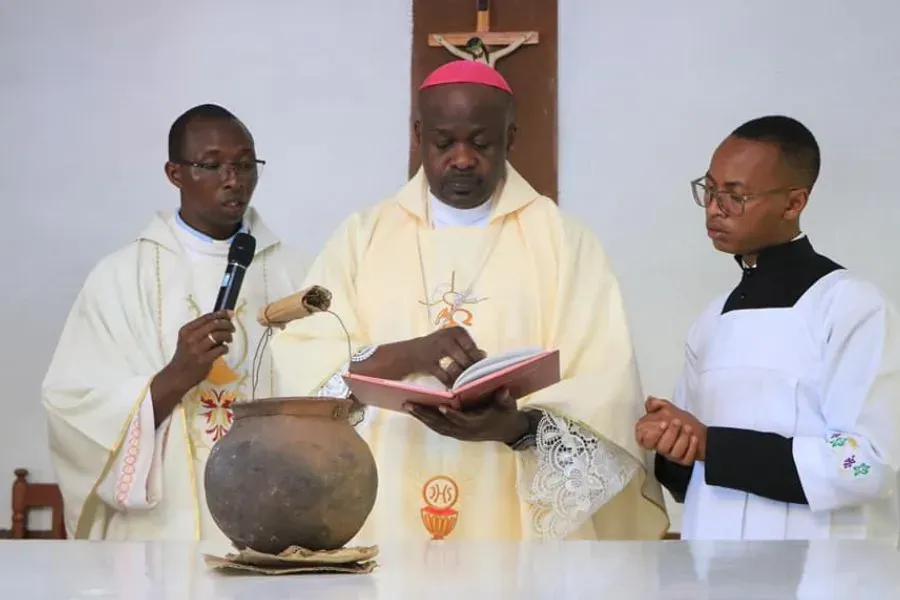“It’s probably why I love Catholicism, because it is so nuts and bolts.”
LaBeouf said that he “experienced disordered freedom for so long, like an anarchist” and that the film changed his life.
At the end of the film, Padre Pio receives the stigmata while in prayer.
“It’s easy to think that because he was holy, that he received the stigma automatically. No,” Rodriguez said. The First World War and the social political turmoil in San Giovanni Rotondo were the context in which the saint received the stigmata, he said.
“Pio was looking at all of this and saying, ‘I want to take this all upon myself as a suffering servant to help them.’ He didn’t know that the stigmata will be the purpose to help these people out. But it ended up being just that. The stigmata didn’t just happen on its own, in other words,” he said.
(Story continues below)
 "Padre Pio," starring Shia LaBeouf, airs in theaters June 2, 2023. Credit: Gravitas Ventures. Credit: Gravitas Ventures
"Padre Pio," starring Shia LaBeouf, airs in theaters June 2, 2023. Credit: Gravitas Ventures. Credit: Gravitas Ventures
Demonic harassment
Padre Pio is harassed by the devil several times in the film, once even physically. In one scene, the devil, in the appearance of a naked woman disrespecting an image of the Virgin Mary, is taunting and discouraging the saint.
Ferrara told CNA that the scene was taken out of Padre Pio’s private letters to his spiritual director. Rodriguez added that demons would appear in Pio’s room as naked women to harass him.
“We’re taking it from his letters. I mean, we’re trying to embody when he’s talking about temptation in a real way,” Ferrara said.
“A lot of what you see in the movie is pretty accurate,” Rodriguez said, adding that he wrote the letters to his spiritual director in confidence and “would not have wanted the letter to be out.”
Rodriguez told CNA in 2022 that the film’s depiction of the saint is about 90% accurate and is largely based on the saint’s letters to his provincial and spiritual director from 1911–1918.
Rodriguez, who became close with LaBeouf during the actor’s preparation for the role of Padre Pio, said that “I know for a fact that God wanted this movie to be made.”
He noted how the film came together at a providential moment in LaBeouf’s life, which put the actor on the path to join the Catholic Church.
LaBeouf recently told ChurchPOP that he is currently in RCIA, taking weekly classes, and is on track to be confirmed in seven months.
Another scene in the film shows the devil appearing as an androgynous person coming to Padre Pio in confession and being unrepentant for sins, even to the point of denying the existence of God and hell.
Once Padre Pio realizes it is the devil, the saint chastises the figure, sends him away, and angrily screams “Shut the f*** up! Say Christ is Lord!”
“When Pio is saying the F-bomb, this is Abel’s take on showing the world that Pio, who is a saint, was also a sinner,” Rodriguez said. He added that in Pio’s letters to his spiritual director, he would write about struggling to deal with his passions of anger and his temper.
At this point in Pio’s life, he is “a saint in the working,” Rodriguez said.
Rodriguez questioned what the world will think of the film’s portrayal of St. Pio “in a more human way.”
“I don’t know what’s going to happen next, but I just hope for the best that the world accepts the movie as it is. And to see why did Pio receive the stigmata? These are the circumstances in which he got the stigmata and the suffering that he went through,” he added.
LaBeouf told CNA that “if you’ve ever read Little Flowers of St. Francis, he says very clearly, and it’s not conjecture, it’s not paraphrased, he says, ‘if the devil approaches you stuff s*** in his mouth.’”
“So this idea that saints — and there is no greater a saint than St. Francis — never cursed is just, like, ignorant, and quite frankly, prude, which isn’t Catholicism. Catholicism isn’t prudish,” he said.
“These are human beings before they’re sainted,” he added.
LaBeouf said that he “walked in [the movie process] a wounded man in full-blown suffering, full-blown shame and panic.”
“And through the course of the movie, I came out of my little shame cave and walked back into the world, found purpose again and redemption again. I was saved. I was lost, and I was saved through the love of Christ,” he said.
“That’s what actually happened in my life. It’s beyond the promotion of this movie. It’s what actually transpired in my life. And shortly after coming out of this film, my wife gave birth, and I’m able to show up for my kid in a way I never would have been able to had this not happened for me,” he said.
Joseph Bukuras is a staff writer at the Catholic News Agency. Joe holds a bachelor’s degree in Political Science from The Catholic University of America. He has interned in the U.S. House of Representatives, on a U.S. Senate campaign, in the Massachusetts State House of Representatives, and at the Susan B. Anthony List. He is based out of the Boston area
 "Padre Pio," starring Shia LaBeouf, airs in theaters June 2, 2023. Credit: Gravitas Ventures
"Padre Pio," starring Shia LaBeouf, airs in theaters June 2, 2023. Credit: Gravitas Ventures




 "Padre Pio," starring Shia LaBeouf, airs in theaters June 2, 2023. Credit: Gravitas Ventures. Credit: Gravitas Ventures
"Padre Pio," starring Shia LaBeouf, airs in theaters June 2, 2023. Credit: Gravitas Ventures. Credit: Gravitas Ventures


